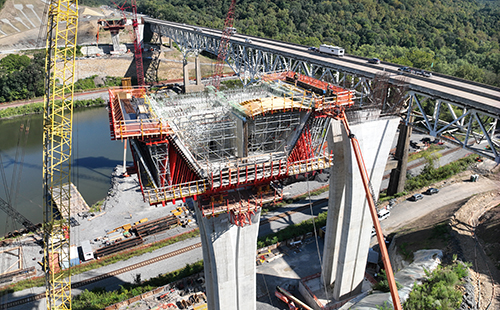In The News
How it Works: Segmental Bridge Construction
October 23, 2024

Every bridge can be divided into two main parts: the substructure and the superstructure. The substructure acts as the foundation of the structure. All piers, abutments, and other support elements fall under this category. Any remaining items above the substructure make up the superstructure.
While the substructure portion of a segmental bridge is virtually indistinguishable from other types of bridges, the superstructure is where things begin to diverge. Segmental bridges lack basic elements that make up a traditional bridge design. They don’t use girders, which typically act as the primary structural supports for the bridge deck due to their high load-bearing capabilities. Instead, their design is fully integral—it’s one complete structure that’s held up with post-tensioning.
All segmental bridges are concrete structures, but the segments come in two types: precast and cast-in-place. Precast segments are poured offsite and brought in on either trucks or barges. This speeds up the erection process, as the concrete doesn’t have to cure onsite. Sometimes, these segments can be too heavy to transport, or the landscape makes it difficult to deliver them, which is where cast-in-place segments come in handy. For the purpose of this post, we’ll be focusing on cast-in-place construction—the kind of bridge Fay, S&B USA Construction is building at our Beaver River Bridge project.
As part of this project, Fay, S&B USA Construction is completing two 1,645-ft 5-span cast-in-place segmental bridges; these new structures will stand 200 ft above the river (which is 20 ft higher than the existing bridge). While segmental bridges are not uncommon, they are unusual to Pennsylvania. There are only two others in the surrounding area: the Turnpike’s Allegheny River Bridge in Harmarville and the Mon Fayette Bridge in Denbo. They’re more common in Israel, where our parent company, Shikun & Binui Ltd., is located. Due to their familiarity with the techniques used, Fay, S&B USA Construction requested experienced individuals from Shikun & Binui Ltd. to aid us during the construction process.
Our bridges at Beaver will be constructed using a balanced cantilever construction process, which is completed in the following series of steps:
Step 1: Construct the pier tables. This signifies the beginning of the construction of the superstructure and will offer a platform and counterweight to support the form travelers.
Step 2: Install the form travelers. These will act as giant molds that will help cast the concrete segments that will create the load-bearing portion of the bridge. Currently, Fay, S&B USA Construction plans to lift parts of the form traveler with a crane, and any remaining pieces will be moved with heavy-duty winches. Four different form travelers (two sets of two) will be used concurrently, which will be placed on both the eastbound (EB) and westbound (WB) structures.
Step 3: Start casting 15-ft segments. Starting on the table of each pier, the form travelers will be used to pour the deck of the bridge in 15-ft segments, following a pattern of one segment up station, countered with one down station. This will prevent the bridge from becoming too heavy on one side.
Step 4: Jump the form travelers from pier to pier. Each of the bridges has four piers—the form travelers will start on piers one and four on the WB structure before they’re moved to piers two and three. Then, they’ll be switched to the EB structure on piers one and four and eventually finish on piers two and three of the EB bridge. Each pier will hold 22 segments before they’re joined together in a closure pour. In total, 176 segments will be cast to create both bridges.
Step 5: Pour any closure segments and post tension the cables. As the segments build out from each pier, adjacent cantilevers will meet in the middle and connect with a closure. Steel-stranded tendons will then be run through the segments inside of ducts during each of the pours to give them durability. After all the segments have been poured, the cables inside will be post tensioned.
Most of segmental bridges’ defining features occur during construction—it’s difficult to tell when a bridge was created using segmental construction techniques after it has been completed. If you’re beside or underneath it, you may be able to pick out faint lines that differentiate between pours, but if you’re driving over top of one, the differences are negligible.
As engineering demands evolve and innovative solutions become increasingly sought after, the segmental cast-in-place balanced cantilever approach will remain an appealing option for overcoming construction challenges and advancing the field of bridge design.
Next Post
October 31, 2024